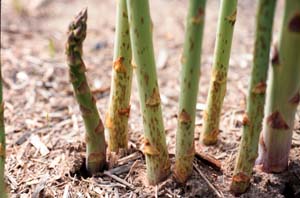Purple spot, caused the soil-borne fungus, Stemphylium vesicarium, can cause problems in cool, wet springs. Symptoms, just like its name, include numerous, sunken oval-shaped spots on spears during the harvest season and more importantly on ferns and stalks during the summer months as long as conditions are ideal for its development.
Twelve hours of wetness is needed for infection and the disease is exacerbated by wind-blown sand injury. Heavy purple spot infection during the summer will lead to premature defoliation which will decrease carbohydrate reserves for the next production season. With the season we had last year and the wet spring we’ve had thus far this year season, pressure due to purple spot may be high. Control of purple spot can be difficult because of management issues (i.e., the mowing and chopping up and leaving of old fern material in the field) and because fungicides can’t be applied during the harvest season. Growers who had pre-mature defoliation issues last year may expect problems this spring. Remember, controlling purple spot begins with preventative fungicide applications during summer and fall by reducing infections to ferns and stalks. Weekly scouting should be done in the spring and followed up with additional scouting and timely fungicide applications once fern stalks are full size. Apply and rotate azoxystrobin (FRAC group 11) at 6.2 to 15.5 fl oz 2.08F/A with chlorothalonil at 2.0 to 4.0 pt/A.
next production season. With the season we had last year and the wet spring we’ve had thus far this year season, pressure due to purple spot may be high. Control of purple spot can be difficult because of management issues (i.e., the mowing and chopping up and leaving of old fern material in the field) and because fungicides can’t be applied during the harvest season. Growers who had pre-mature defoliation issues last year may expect problems this spring. Remember, controlling purple spot begins with preventative fungicide applications during summer and fall by reducing infections to ferns and stalks. Weekly scouting should be done in the spring and followed up with additional scouting and timely fungicide applications once fern stalks are full size. Apply and rotate azoxystrobin (FRAC group 11) at 6.2 to 15.5 fl oz 2.08F/A with chlorothalonil at 2.0 to 4.0 pt/A.
(Photo by M. Hausbeck, Michigan State University)

